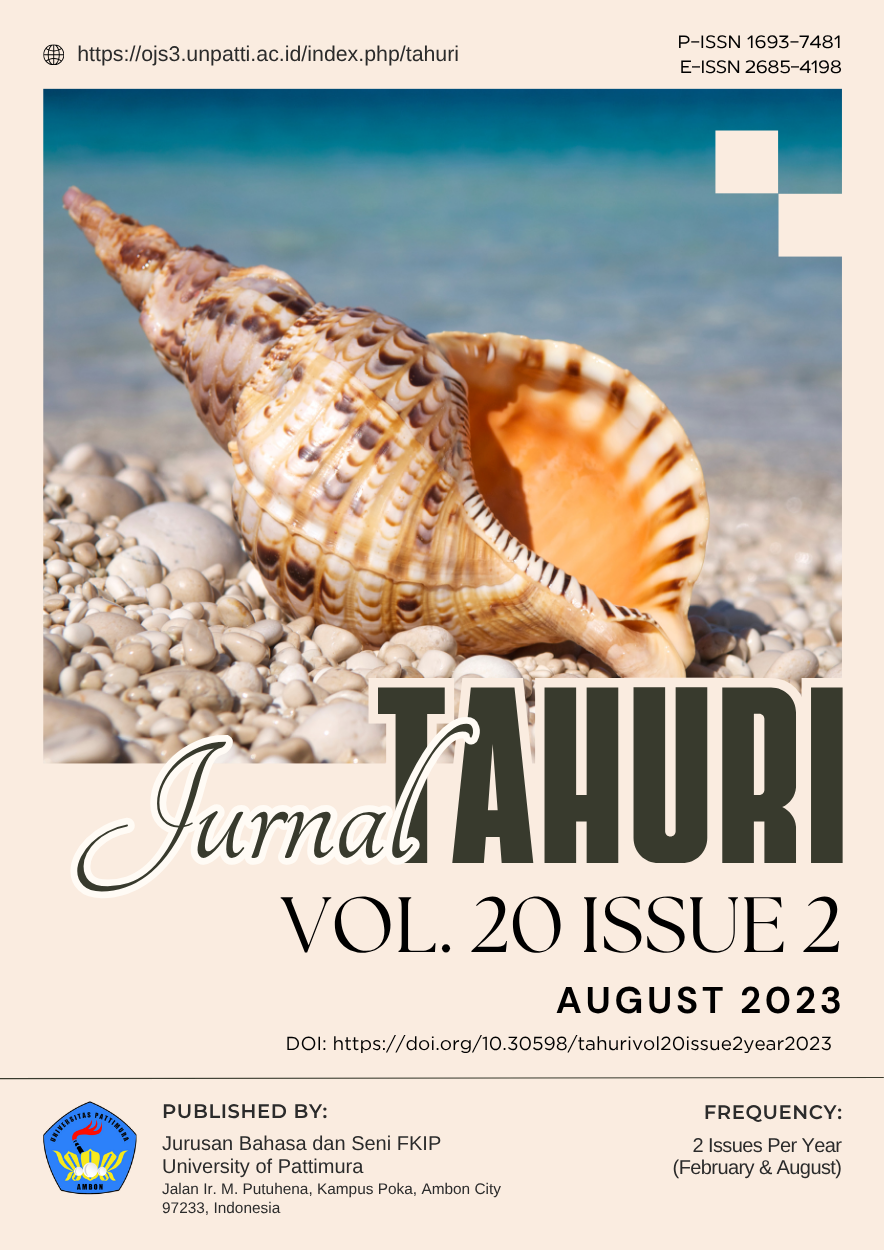Intersecting Voices: Gender, Religion, and Language Practices among University Students in Eastern Indonesia
Abstract
Language functions not merely as a means of communication but as a social arena where gender and religious identities are continuously negotiated and redefined. This study analyzes how language practices among students at Pattimura University reflect and construct social ideologies related to gender and religion within academic and everyday interactions. Using a Critical Discourse Analysis (CDA) approach within a sociocultural linguistics framework, data were collected through classroom observations, informal conversations in campus public spaces, social media interactions, and in-depth interviews. The analysis followed three stages: textual analysis, discursive practice analysis, and social practice analysis. Findings reveal that address terms and religious expressions, such as “abang/babang” and “bung/bu” for male students, “caca” and “ussy” for female students, and faith-based utterances in daily interactions, serve as linguistic markers of intercommunity identity. These practices demonstrate linguistic accommodation as a strategy for maintaining social harmony while preserving symbolic boundaries between groups. Moreover, gendered positioning emerges as male students often dominate conversational spaces, whereas female students negotiate social positioning through more subtle discursive strategies. The study’s novelty lies in introducing the concept of Interfaith Gendered Discourse, which highlights the simultaneous intersection of gender and religion in linguistic practice. It calls for strengthening critical cross-identity literacy in higher education and expanding sociolinguistic inquiry into multicultural contexts of Eastern Indonesia.
Downloads
References
Admirand, P. (2019). Humbling the Discourse: Why Interfaith Dialogue, Religious Pluralism, Liberation Theology, and Secular Humanism Are Needed for a Robust Public Square. Religions, 10(8), 450–460. https://doi.org/10.3390/rel10080450
Apituley, P. S., Lestuny, C., & Soumokil, P. (2022). Application of the Metaphor Approach in German Learning at SMA Negeri 7 Ambon. Jurnal Tahuri, 19(1), 29–35. https://doi.org/10.30598/tahurivol19issue1page29-35
Bacon, C. K., & Kim, S. Y. (2018). “English is my only weapon”: Neoliberal language ideologies and youth metadiscourse in South Korea. Linguistics and Education, 48(1), 10–21. https://doi.org/10.1016/j.linged.2018.09.002
Bräuchler, B. (2022). Artivism in Maluku. The Asia Pacific Journal of Anthropology, 23(1), 40–58. https://doi.org/10.1080/14442213.2021.2003426
Chang-Bacon, C. K. (2022). Who’s being ‘sheltered?’: How monolingual language ideologies are produced within education policy discourse and sheltered English immersion. Critical Studies in Education, 63(2), 212–228. https://doi.org/10.1080/17508487.2020.1720259
Erdocia, I. (2019). Medium of instruction ideologies: accommodation of multilingualism in the bilingual regime of Navarre. Current Issues in Language Planning, 20(3), 284–308. https://doi.org/10.1080/14664208.2018.1503457
Fitzsimmons‐Doolan, S. (2018). Language Ideology Change Over Time: Lessons for Language Policy in the U.S. State of Arizona and Beyond. TESOL Quarterly, 52(1), 34–61. https://doi.org/10.1002/tesq.371
Gao, F. (2021). Negotiation of native linguistic ideology and cultural identities in English learning: a cultural schema perspective. Journal of Multilingual and Multicultural Development, 42(6), 551–564. https://doi.org/10.1080/01434632.2020.1857389
Gaspersz, S. G. C. (2023). Muslim-Christian and Missiological Discourses on Cultural Identity in Maluku, Eastern Indonesia. Mission Studies, 40(3), 391–411. https://doi.org/10.1163/15733831-12341929
Gaspersz, S. G. C., & Souisa, N. N. (2023). Negotiating Religious Identities and Modernity in Maluku: A Socio-Historical Perspective. Religió Jurnal Studi Agama-Agama, 13(1), 41–69. https://doi.org/10.15642/religio.v13i1.2260
Guillen, D. E. F. (2019). Qualitative research paradigm, a key research design for educational researchers, processes and procedures: A theoretical overview. Propósitos y Representaciones, 7(1), 201–216. https://doi.org/10.20511/pyr2019.v7n1.267
Hickey-Moody, A., & Willcox, M. (2019). Entanglements of Difference as Community Togetherness: Faith, Art and Feminism. Social Sciences, 8(9), 264–278. https://doi.org/10.3390/socsci8090264
Hukunala, M., & Angkotasan, S. (2022). Aspirasi Afektif dan Hasrat yang Dimediasi: Peran Media Sosial dan Drama Korea dalam Membentuk Idealisme Romantis Kalangan Mahasiswa di Ambon. Populis: Jurnal Ilmu Sosial Dan Ilmu Politik, 17(1), 105–120. https://doi.org/10.30598/populisvol17iss1pp105-120
Irvine, J. T. (2018). Divided Values, Shadow Languages: Positioning and Perspective in Linguistic Ideologies. Signs and Society, 6(1), 25–44. https://doi.org/10.1086/695142
Kadir, H. A. (2023). (Re)building Interethnic Relations Through Sharecropping in Post-Conflict Maluku. The Asia Pacific Journal of Anthropology, 24(2), 153–170. https://doi.org/10.1080/14442213.2022.2155233
Kroskrity, P. V. (2018). On recognizing persistence in the Indigenous language ideologies of multilingualism in two Native American Communities. Language & Communication, 62(2), 133–144. https://doi.org/10.1016/j.langcom.2018.04.012
Lindsay, J. (2020). Interfaith Dialogue and Humanization of the Religious Other: Discourse and Action. International Journal of Interreligious and Intercultural Studies, 3(2), 1–24. https://doi.org/10.32795/ijiis.vol3.iss2.2020.691
Liu, Y. (2022). Commodification of the Chinese language: investigating language ideology in the Chinese complementary schools’ online discourse. Current Issues in Language Planning, 23(3), 319–342. https://doi.org/10.1080/14664208.2022.2037290
Maxwell, J. A., & Levitt, H. M. (2023). How qualitative methods advance the study of causation in psychotherapy research. Psychotherapy Research, 33(8), 1019–1030. https://doi.org/10.1080/10503307.2023.2181112
Phyak, P., & Sharma, B. K. (2021). Regimes of linguistic entrepreneurship: neoliberalism, the entanglement of language ideologies and affective regime in language education policy. Multilingua, 40(2), 199–224. https://doi.org/10.1515/multi-2020-0031
Priya, A. (2021). Case Study Methodology of Qualitative Research: Key Attributes and Navigating the Conundrums in Its Application. Sociological Bulletin, 70(1), 94–110. https://doi.org/10.1177/0038022920970318
Rosen, Z. P. (2023). A BERT’s Eye View: A Big Data Framework for Assessing Language Convergence and Accommodation. Journal of Language and Social Psychology, 42(1), 60–81. https://doi.org/10.1177/0261927X221095865
Sian, K. P. (2021). “Love Jihad”, “Forced” Conversion Narratives, and Interfaith Marriage in the Sikh Diaspora. Religions, 12(12), 1085. https://doi.org/10.3390/rel12121085
Slee, R. (2018). Clauses of conditionality: the ‘reasonable’ accommodation of language. In Disability and Society (pp. 107–122). Routledge. https://doi.org/10.4324/9781315841984-8
Sung, C. C. M. (2022). English only or more?: Language ideologies of international students in an EMI university in multilingual Hong Kong. Current Issues in Language Planning, 23(3), 275–295. https://doi.org/10.1080/14664208.2021.1986299
Toisuta, H., Ernas, S., & Wakano, A. (2023). Salafi Movement Post-Conflict Ambon: A Search for Identity in Maluku. Journal of Al-Tamaddun, 18(2), 133–151. https://doi.org/10.22452/JAT.vol8no2.10
Udiyasa, K., & Madubun, J. (2023). Kolaborasi Triple Helix dalam Program Inovasi Desa: Mendorong Ekonomi Berbasis Pengetahuan di Desa Poka, Kota Ambon. Populis: Jurnal Ilmu Sosial Dan Ilmu Politik, 18(1), 32–49. https://doi.org/10.30598/populis.18.1.32-49
Verma, S., & Sukhramani, N. (2018). Interfaith Marriages and Negotiated Spaces. Society and Culture in South Asia, 4(1), 16–43. https://doi.org/10.1177/2393861717730620
Wilson, A. (2018). International tourism and (linguistic) accommodation: Convergence towards and through English in tourist information interactions. Anglophonia, 25(25), 987–1000. https://doi.org/10.4000/anglophonia.1377
Copyright (c) 2023 Afdhal Afdhal

This work is licensed under a Creative Commons Attribution 4.0 International License.




